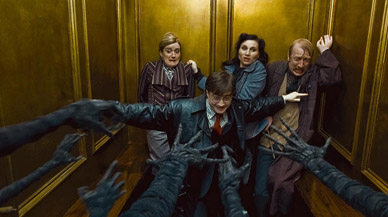Movie Review: Harry Potter and the Deathly Hallows Part 1
By Matthew Huntley
November 23, 2010
BoxOfficeProphets.com

That’s why we can no longer approach the Harry Potter series strictly as children’s fantasy. It now hovers between fantasy and drama, and the characters’ choices are no longer about coming-of-age issues like dating and first kisses, but more serious subjects like responsibility and survival. These themes have always been a part of the Harry Potter universe, but they’ve now taken on a greater significance and priority. It’s almost as if Harry (Daniel Radcliffe), Ron (Rupert Grint) and Hermione (Emma Watson), the heroes of saga, have entered a point of no return. For them, life as wizards and witch is no longer novel and fun; it’s something they must rely on to evade danger and survive.
All this makes Harry Potter and the Deathly Hallows Part 1 sound like a morbid, dreadful experience, but just as the characters face their new challenges, the filmmakers prove they’re up to the task of relaying them in a dramatic, engaging way. Director David Yates respects the characters’ newfound sensibilities and instead of trying to mask them with cute special effects and bright photography, he goes to the heart of their dilemma and takes the material seriously, and we respond to it. Whereas the previous Harry Potter films were sillier, lighter and more action-driven, Deathly Hallows Part 1 is more grave and realistic (or at least as realistic as a story like this could be), forcing us to really ponder the characters’ situation and how life as a wizard or witch is not always fun and cheerful.
What is the characters’ situation? If you’re not new to the series, then you know Professor Dumbledore (Michael Gambon), the former headmaster of Hogwarts School of Witchcraft and Wizardry (and Harry’s beloved mentor), was killed at the end of Harry Potter and the Half-Blood Prince. He died at the hands, or wand, of Professor Snape (Alan Rickman), who was carrying out the orders of Harry’s sworn enemy, the evil Lord Voldemort (Ralph Fiennes), whom Harry has learned fragmented his soul into a series Horcruxes as a way of obtaining immortality (a Horcrux is any object, living or inanimate, that stores a piece of someone’s soul each time they commit murder; Voldemort is up to seven). Now Harry and his friends are on a world mission to locate the remaining Horcruxes and destroy them (Dumbledore and Harry have already destroyed two), which would allow Voldemort to become mortal and vulnerable.
The plot no longer has the luxury of featuring the Hogwarts School or its colorful students and professors. Most of it takes place outside in cold, damp locations like the woods and mountaintops, where Harry, Ron and Hermione hide from their enemies and devise ways of locating the Horcruxes. For the most part, they are the only characters on-screen for the bulk of the film, and while the middle section doesn’t have the same rhythm and sense of urgency as its predecessors, it has a greater observation of its characters. We get a strong sense of the strain the heroes’ journey is having on them and come to understand and care for them on a deeper level. We no longer view them as children or teenagers, but as fully realized adults who can no longer be easily protected. Even though I can guess how the overall story will turn out, I wasn’t certain of Harry, Ron and Hermione’s safety in Deathly Hallows Part 1, and that’s a sign of good storytelling.
As with every Harry Potter movie, the production values and special effects are exceptional and exciting to watch, especially some gruesome scenes involving a snake, but the real wealth of this seventh film comes from the performances of its young cast. Radcliffe, Grint and Watson give their characters more weight and presence than ever before and I actually looked beyond them as actors fulfilling popular roles; this time they embodied them with greater passion and conviction.
Yates manifests a lot of patience and reflection from J.K. Rowling’s novel and we get a real sense of Harry, Ron and Hermione’s agonizing ordeal. The point, now, is for us to empathize with them as much as possible so their anticipated victory means as much as it can during the climax that will be Deathly Hallows Part I2. I responded to one scene in particular that takes place in a tent, where Harry and Hermione are feeling tired and hopeless, and Harry decides to lighten the mood. It is a sad and sweet moment that’s made all the more beautiful because no dialogue is spoken (and there doesn’t need to be).
I haven’t read the Harry Potter novels, so I can’t say with absolute certainty where the literary series shed the last of its childlike qualities, but from a filmic standpoint, I would say that time is now. The Deathly Hallows Part 1 is not as joyful or magical as the other films, but that seems inevitable given the point in the story where the characters now find themselves. Their childhood innocence may be gone, but it’s their upcoming adventures as adults that keep us involved in their lives and hoping their present journey ends in their favor. We have come to care about them that much.